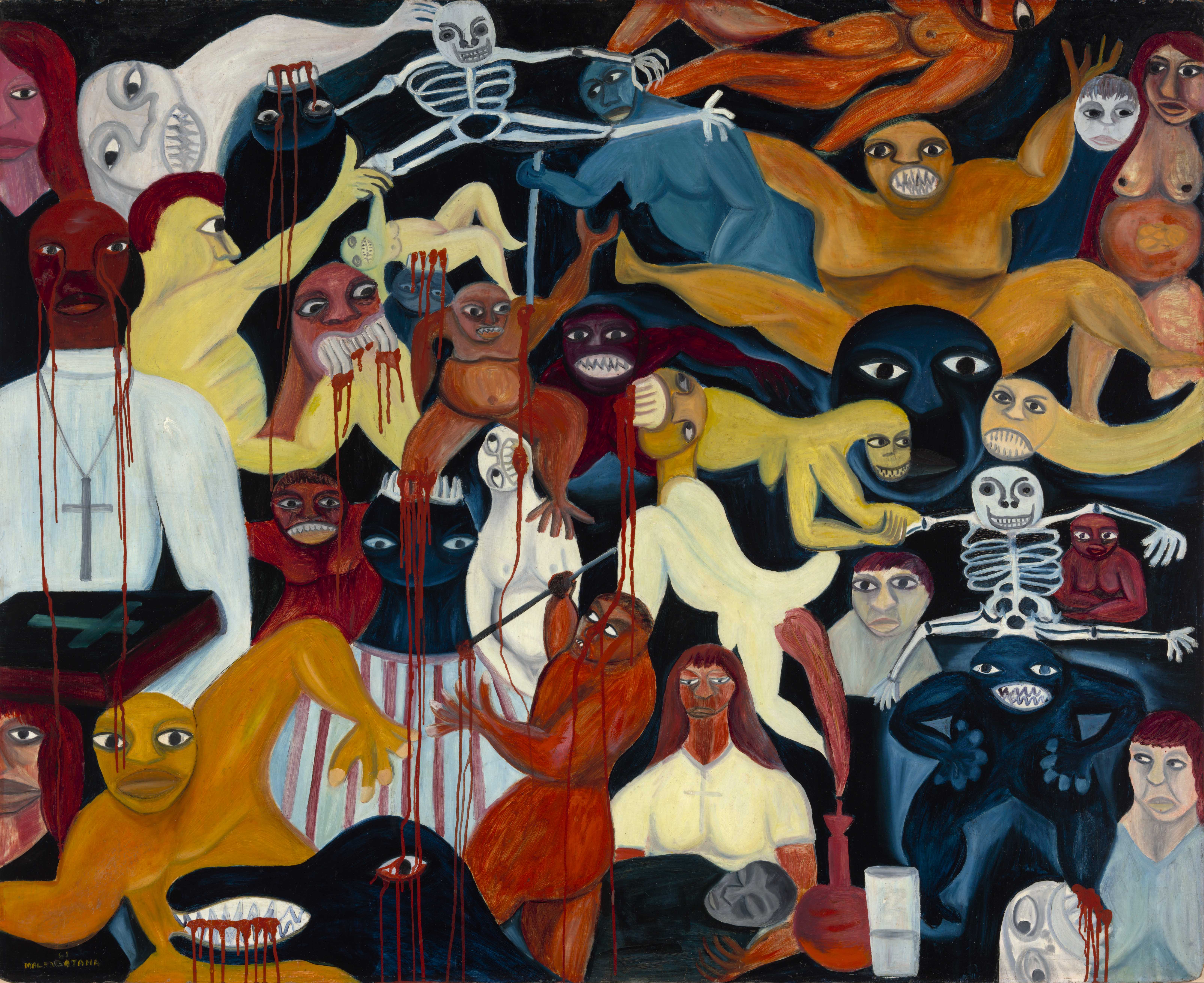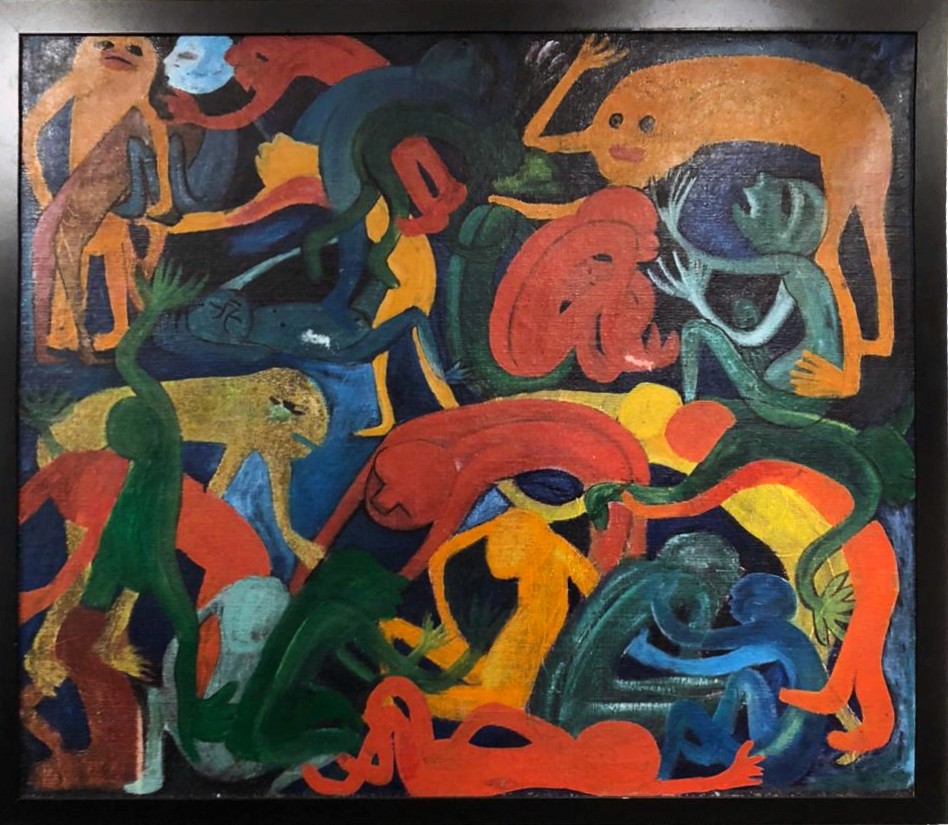Malangatana Ngwenya
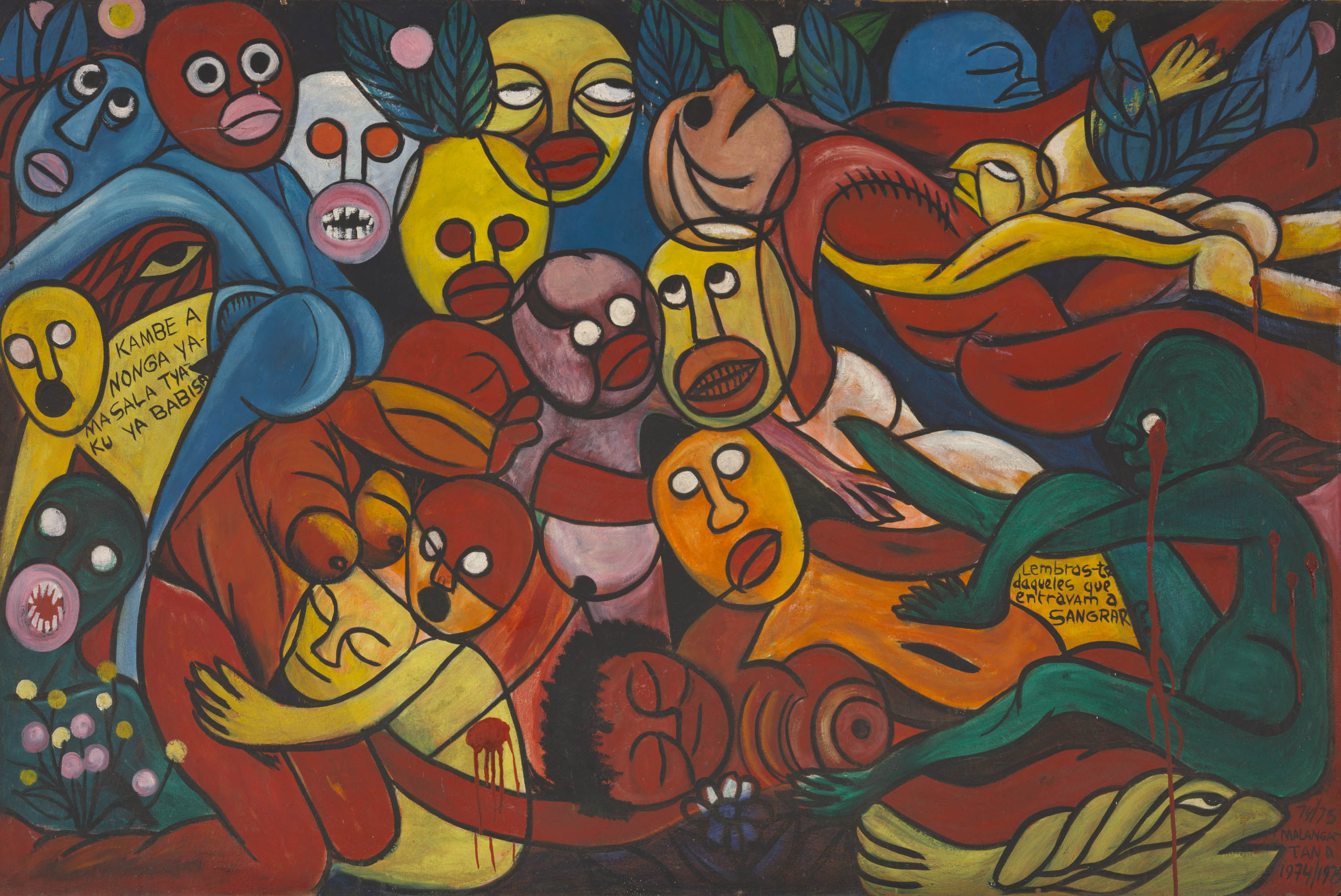
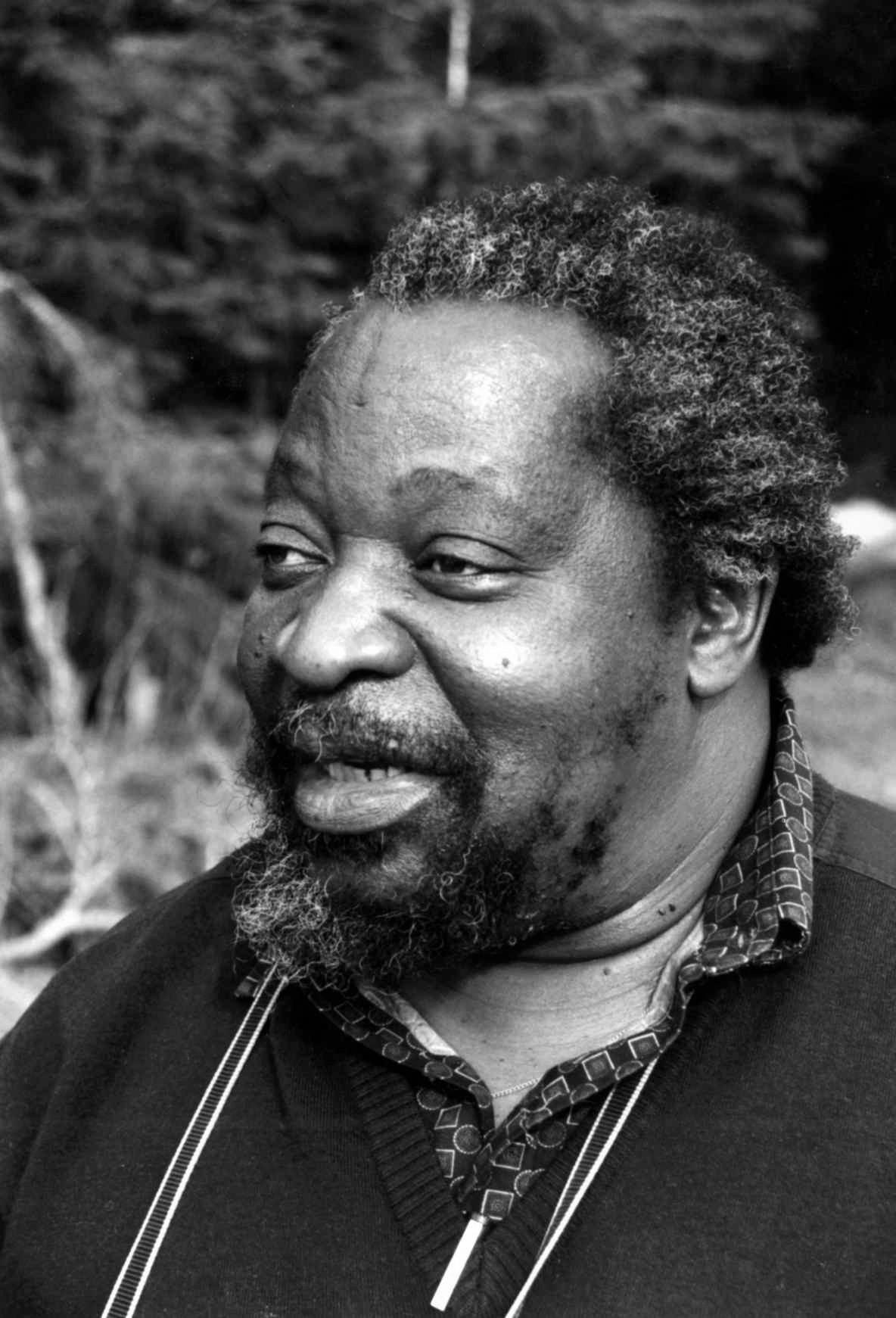



Malangatana Valente Ngwenya (b. 6 June 1936 - 5 January 2011, Mozambique) commonly known as Malangatana, a painter and poet, developed his unique painting style early in his career. An aesthetic defined by an allegorical approach to painting a dense assembly of figures; fictional depictions of animals, humans, and supernatural creatures in a palette of both bright and dark colors.
A Portuguese colony until 1975 the changes in Mozambique's political history during the 1960s and 1970s significantly impacted Malangatana's life and oeuvre. His work embodies the new artistic vocabularies that arose in Mozambique in tandem with the struggle for a liberated nation. Visiting themes of conflict, injustices of colonial rule, religious tension and liberation in his homeland, internationally acclaimed Malangatana was a pioneer of African modernism. Today, his works offer insights into the perpetuating process of decolonization.
Born in the town of Matalana, southern Mozambique in 1936 at the height of Portuguese colonialism, Malangatana's early years were marked by the growth of the national liberation struggle and the coming of independence in 1975. He began painting in the late 1950's at the Industrial school and the Art Club of Mozambique in Maputo. Under the mentorship of Augusto Cabral and Pancho Guedes, he developed their instructions from European modernism into the unique allegorical signature style he became recognized for. In 1959 Malangatana's works were exhibited publicly for the first time as part of a group show and in 1961 he had his first solo exhibition. The show included the work Juizo Final. 1961 (Final Judgment), which depicted the brutality of life under colonial rule.
Malangatana's support for Mozambique's struggles as a member of the Liberation front of Mozambique, resulted in his 18 month imprisonment. Upon his release he received a grant to study ceramics and printmaking in Portugal. Malangatana made his debut solo exhibition in Lisbon in March 1972. Ahead of Mozambique's independence 3 years later, Malangatana returned to his homeland, serving as representative to parliament and continued as a full time artist. His poetry was published in Black Orpheus Magazine and in the Penguin Book of Modern Poetry from Africa.
Malangatana's artwork has been exhibited globally and is held in a number of private and public collections. He was awarded the Nachingwea Medal for Contribution to Mozambican Culture and in 1997 was named a UNESCO Artist for Peace. He remained committed throughout the remainder of his life to establishing cultural institutions in Mozambique, including the National Museum of Art, the Centre for Cultural Studies and the Centre for the Arts.
In July 2020 The Art Institute of Chicago opened Malangatana: Mozambique Modern at The Institute, hosted in association with the Foundation Malangatana Valente Ngwenya (FMVN) and Gallery MOMO. This presentation is both the first survey of Malangatana's early work since his death and the first solo exhibition of a modern African painter at the Art Institute. Bringing together over forty key paintings and drawings, the exhibition highlights the years between 1959 and 1975 as a period in which Malangatana embarked on bold formal experiments and painted the rapidly changing world around him, inviting us to consider his development as an artist part and parcel with the emergence of modern African art.
Malangatana Valente Ngwenya (b. 6 June 1936 - 5 January 2011, Mozambique) commonly known as Malangatana, a painter and poet, developed his unique painting style early in his career. An aesthetic defined by an allegorical approach to painting a dense assembly of figures; fictional depictions of animals, humans, and supernatural creatures in a palette of both bright and dark colors.
A Portuguese colony until 1975 the changes in Mozambique's political history during the 1960s and 1970s significantly impacted Malangatana's life and oeuvre. His work embodies the new artistic vocabularies that arose in Mozambique in tandem with the struggle for a liberated nation. Visiting themes of conflict, injustices of colonial rule, religious tension and liberation in his homeland, internationally acclaimed Malangatana was a pioneer of African modernism. Today, his works offer insights into the perpetuating process of decolonization.
Born in the town of Matalana, southern Mozambique in 1936 at the height of Portuguese colonialism, Malangatana's early years were marked by the growth of the national liberation struggle and the coming of independence in 1975. He began painting in the late 1950's at the Industrial school and the Art Club of Mozambique in Maputo. Under the mentorship of Augusto Cabral and Pancho Guedes, he developed their instructions from European modernism into the unique allegorical signature style he became recognized for. In 1959 Malangatana's works were exhibited publicly for the first time as part of a group show and in 1961 he had his first solo exhibition. The show included the work Juizo Final. 1961 (Final Judgment), which depicted the brutality of life under colonial rule.
Malangatana's support for Mozambique's struggles as a member of the Liberation front of Mozambique, resulted in his 18 month imprisonment. Upon his release he received a grant to study ceramics and printmaking in Portugal. Malangatana made his debut solo exhibition in Lisbon in March 1972. Ahead of Mozambique's independence 3 years later, Malangatana returned to his homeland, serving as representative to parliament and continued as a full time artist. His poetry was published in Black Orpheus Magazine and in the Penguin Book of Modern Poetry from Africa.
Malangatana's artwork has been exhibited globally and is held in a number of private and public collections. He was awarded the Nachingwea Medal for Contribution to Mozambican Culture and in 1997 was named a UNESCO Artist for Peace. He remained committed throughout the remainder of his life to establishing cultural institutions in Mozambique, including the National Museum of Art, the Centre for Cultural Studies and the Centre for the Arts.
In July 2020 The Art Institute of Chicago opened Malangatana: Mozambique Modern at The Institute, hosted in association with the Foundation Malangatana Valente Ngwenya (FMVN) and Gallery MOMO. This presentation is both the first survey of Malangatana's early work since his death and the first solo exhibition of a modern African painter at the Art Institute. Bringing together over forty key paintings and drawings, the exhibition highlights the years between 1959 and 1975 as a period in which Malangatana embarked on bold formal experiments and painted the rapidly changing world around him, inviting us to consider his development as an artist part and parcel with the emergence of modern African art.
Malangatana Valente Ngwenya (b. 6 June 1936 - 5 January 2011, Mozambique) commonly known as Malangatana, a painter and poet, developed his unique painting style early in his career. An aesthetic defined by an allegorical approach to painting a dense assembly of figures; fictional depictions of animals, humans, and supernatural creatures in a palette of both bright and dark colors.
A Portuguese colony until 1975 the changes in Mozambique's political history during the 1960s and 1970s significantly impacted Malangatana's life and oeuvre. His work embodies the new artistic vocabularies that arose in Mozambique in tandem with the struggle for a liberated nation. Visiting themes of conflict, injustices of colonial rule, religious tension and liberation in his homeland, internationally acclaimed Malangatana was a pioneer of African modernism. Today, his works offer insights into the perpetuating process of decolonization.
Born in the town of Matalana, southern Mozambique in 1936 at the height of Portuguese colonialism, Malangatana's early years were marked by the growth of the national liberation struggle and the coming of independence in 1975. He began painting in the late 1950's at the Industrial school and the Art Club of Mozambique in Maputo. Under the mentorship of Augusto Cabral and Pancho Guedes, he developed their instructions from European modernism into the unique allegorical signature style he became recognized for. In 1959 Malangatana's works were exhibited publicly for the first time as part of a group show and in 1961 he had his first solo exhibition. The show included the work Juizo Final. 1961 (Final Judgment), which depicted the brutality of life under colonial rule.
Malangatana's support for Mozambique's struggles as a member of the Liberation front of Mozambique, resulted in his 18 month imprisonment. Upon his release he received a grant to study ceramics and printmaking in Portugal. Malangatana made his debut solo exhibition in Lisbon in March 1972. Ahead of Mozambique's independence 3 years later, Malangatana returned to his homeland, serving as representative to parliament and continued as a full time artist. His poetry was published in Black Orpheus Magazine and in the Penguin Book of Modern Poetry from Africa.
Malangatana's artwork has been exhibited globally and is held in a number of private and public collections. He was awarded the Nachingwea Medal for Contribution to Mozambican Culture and in 1997 was named a UNESCO Artist for Peace. He remained committed throughout the remainder of his life to establishing cultural institutions in Mozambique, including the National Museum of Art, the Centre for Cultural Studies and the Centre for the Arts.
In July 2020 The Art Institute of Chicago opened Malangatana: Mozambique Modern at The Institute, hosted in association with the Foundation Malangatana Valente Ngwenya (FMVN) and Gallery MOMO. This presentation is both the first survey of Malangatana's early work since his death and the first solo exhibition of a modern African painter at the Art Institute. Bringing together over forty key paintings and drawings, the exhibition highlights the years between 1959 and 1975 as a period in which Malangatana embarked on bold formal experiments and painted the rapidly changing world around him, inviting us to consider his development as an artist part and parcel with the emergence of modern African art.
Malangatana Valente Ngwenya (b. 6 June 1936 - 5 January 2011, Mozambique) commonly known as Malangatana, a painter and poet, developed his unique painting style early in his career. An aesthetic defined by an allegorical approach to painting a dense assembly of figures; fictional depictions of animals, humans, and supernatural creatures in a palette of both bright and dark colors.
A Portuguese colony until 1975 the changes in Mozambique's political history during the 1960s and 1970s significantly impacted Malangatana's life and oeuvre. His work embodies the new artistic vocabularies that arose in Mozambique in tandem with the struggle for a liberated nation. Visiting themes of conflict, injustices of colonial rule, religious tension and liberation in his homeland, internationally acclaimed Malangatana was a pioneer of African modernism. Today, his works offer insights into the perpetuating process of decolonization.
Born in the town of Matalana, southern Mozambique in 1936 at the height of Portuguese colonialism, Malangatana's early years were marked by the growth of the national liberation struggle and the coming of independence in 1975. He began painting in the late 1950's at the Industrial school and the Art Club of Mozambique in Maputo. Under the mentorship of Augusto Cabral and Pancho Guedes, he developed their instructions from European modernism into the unique allegorical signature style he became recognized for. In 1959 Malangatana's works were exhibited publicly for the first time as part of a group show and in 1961 he had his first solo exhibition. The show included the work Juizo Final. 1961 (Final Judgment), which depicted the brutality of life under colonial rule.
Malangatana's support for Mozambique's struggles as a member of the Liberation front of Mozambique, resulted in his 18 month imprisonment. Upon his release he received a grant to study ceramics and printmaking in Portugal. Malangatana made his debut solo exhibition in Lisbon in March 1972. Ahead of Mozambique's independence 3 years later, Malangatana returned to his homeland, serving as representative to parliament and continued as a full time artist. His poetry was published in Black Orpheus Magazine and in the Penguin Book of Modern Poetry from Africa.
Malangatana's artwork has been exhibited globally and is held in a number of private and public collections. He was awarded the Nachingwea Medal for Contribution to Mozambican Culture and in 1997 was named a UNESCO Artist for Peace. He remained committed throughout the remainder of his life to establishing cultural institutions in Mozambique, including the National Museum of Art, the Centre for Cultural Studies and the Centre for the Arts.
In July 2020 The Art Institute of Chicago opened Malangatana: Mozambique Modern at The Institute, hosted in association with the Foundation Malangatana Valente Ngwenya (FMVN) and Gallery MOMO. This presentation is both the first survey of Malangatana's early work since his death and the first solo exhibition of a modern African painter at the Art Institute. Bringing together over forty key paintings and drawings, the exhibition highlights the years between 1959 and 1975 as a period in which Malangatana embarked on bold formal experiments and painted the rapidly changing world around him, inviting us to consider his development as an artist part and parcel with the emergence of modern African art.
selected artworks
view all
view all
view all
view all
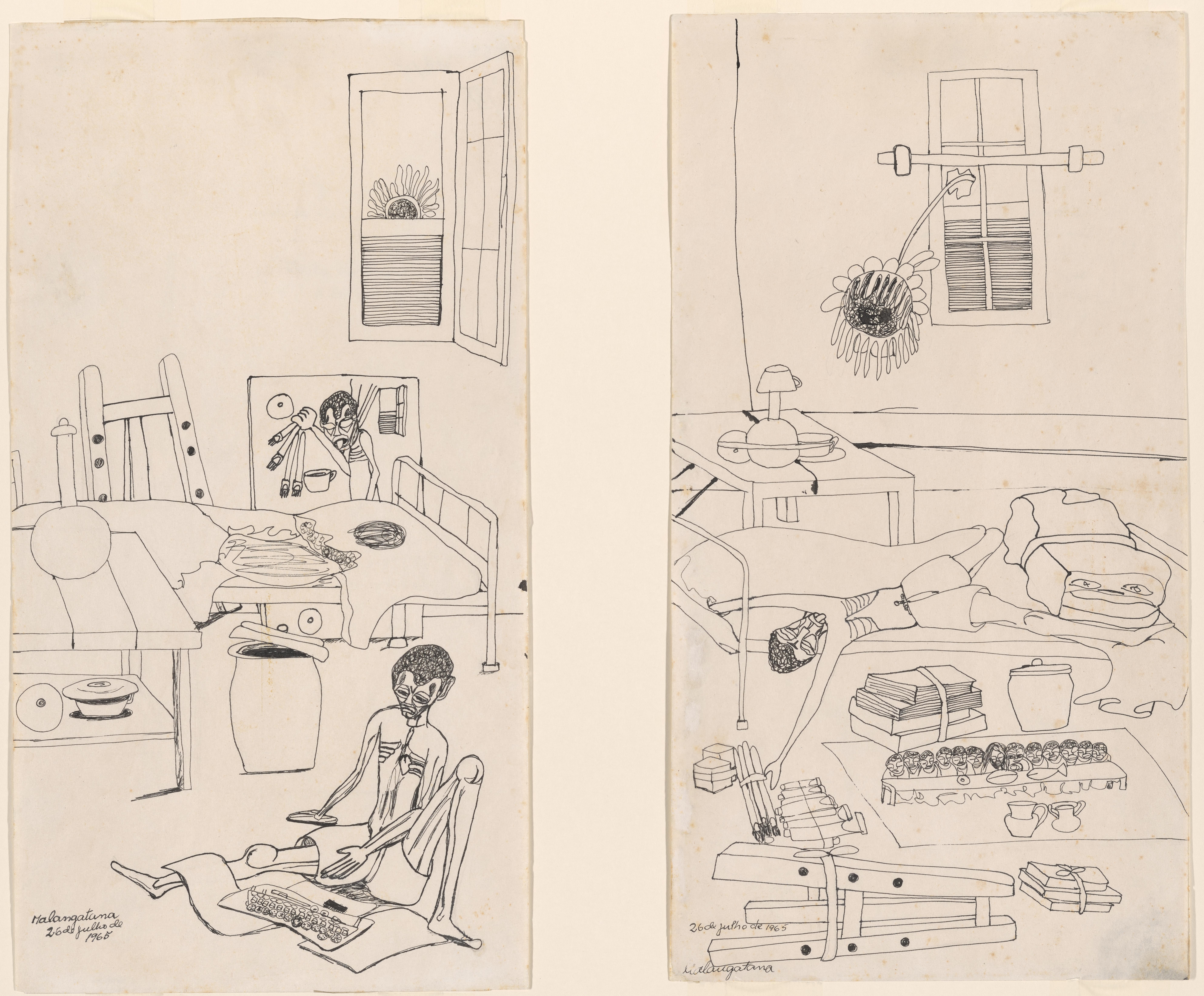


The suicide of the prisoner III and IV
Pen and Black Ink on Paper
Pen and Black Ink on Paper
Pen and Black Ink on Paper
Pen and Black Ink on Paper
60cm x 75cm
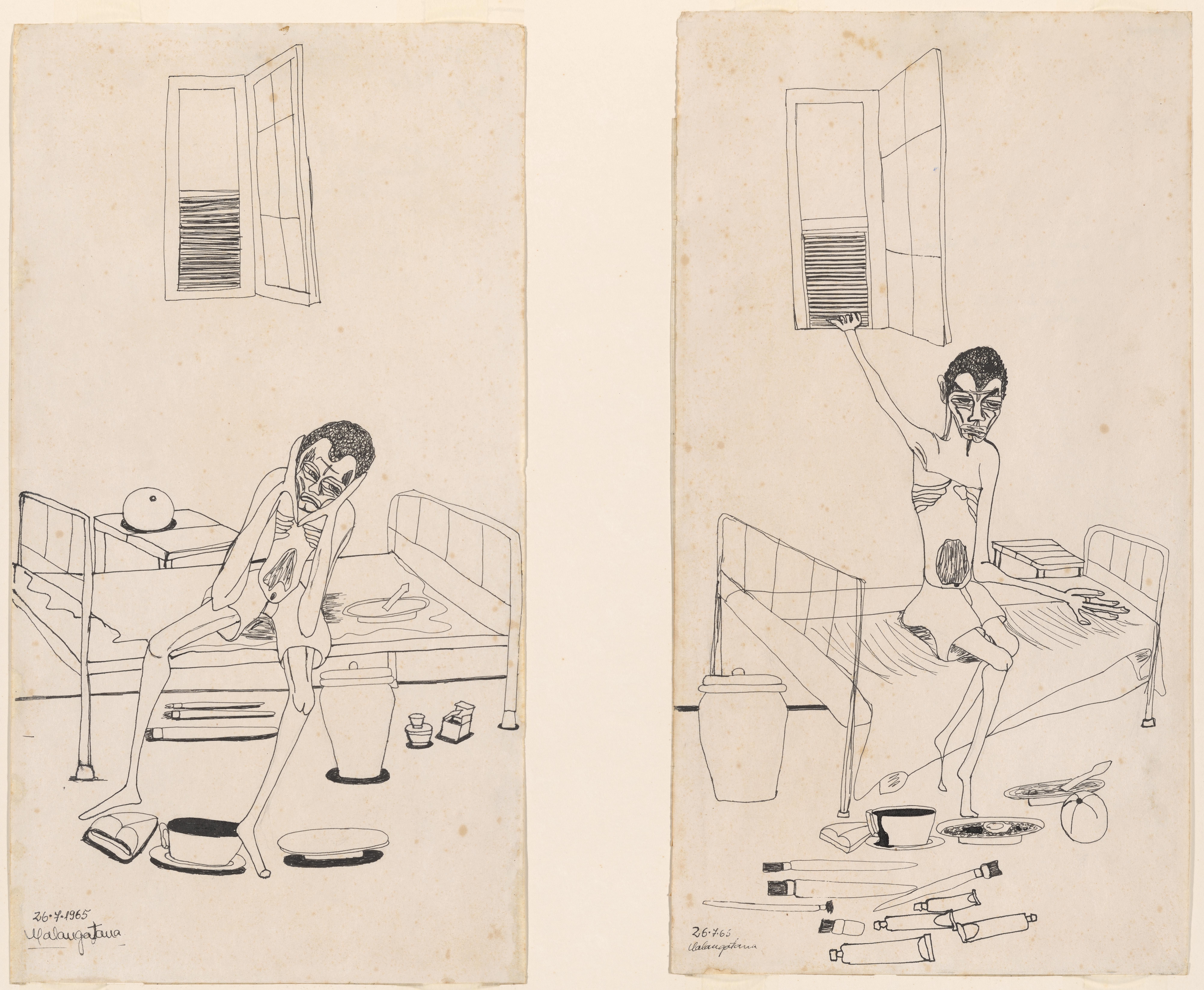


The suicide of the prisoner I and II
Pen and Black Ink on Paper
Pen and Black Ink on Paper
Pen and Black Ink on Paper
Pen and Black Ink on Paper
60cm x 75cm
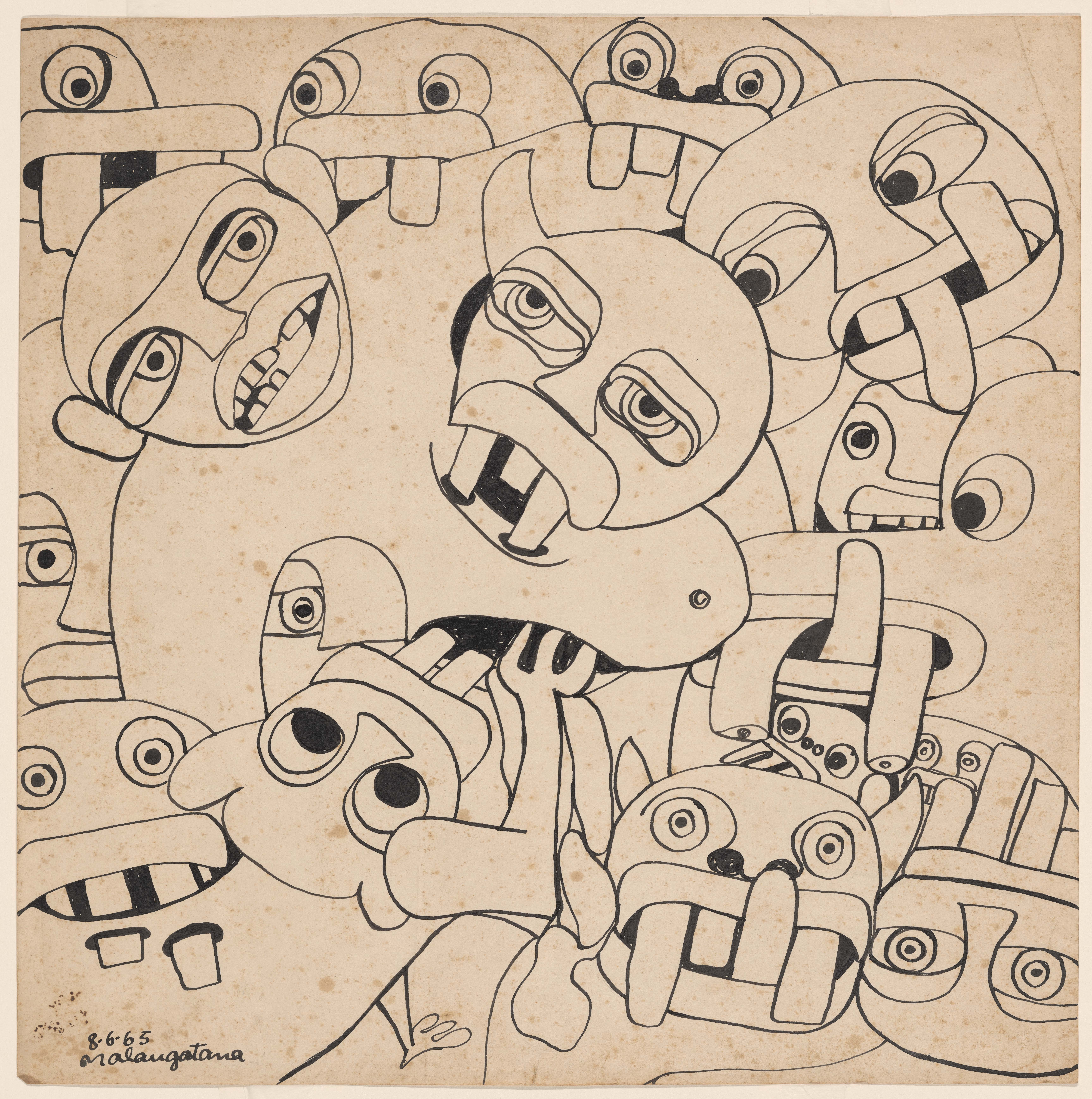


Devouring
Pen and Black Ink on Paper
Pen and Black Ink on Paper
Pen and Black Ink on Paper
Pen and Black Ink on Paper
75cm x 65cm
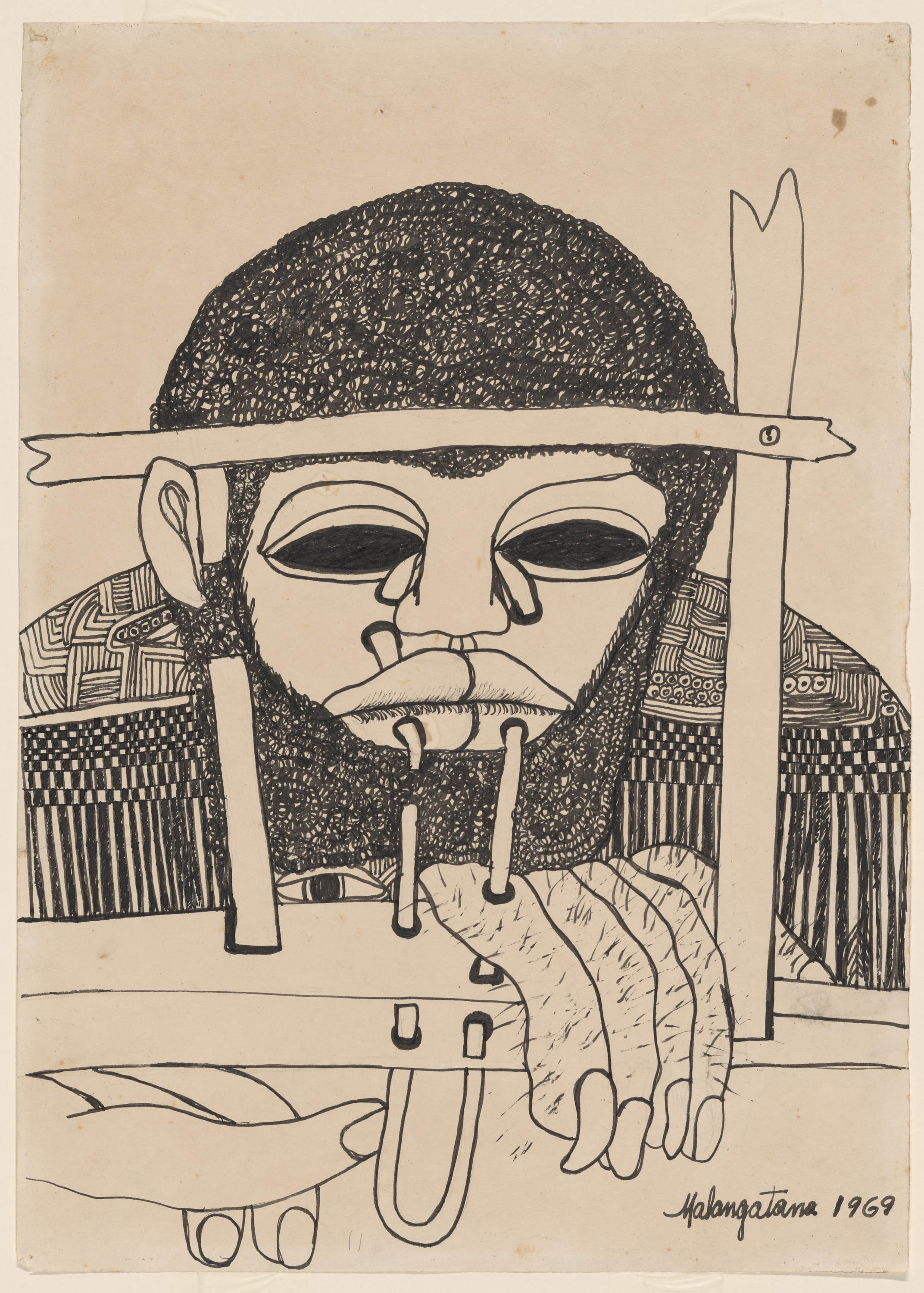


The Prisoner
Pen and Black Ink on Paper
Pen and Black Ink on Paper
Pen and Black Ink on Paper
Pen and Black Ink on Paper
75cm x 65cm
VIEW ALL ARTISTS

